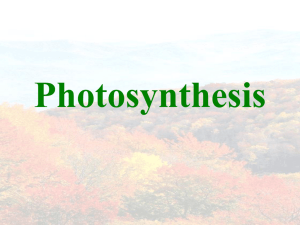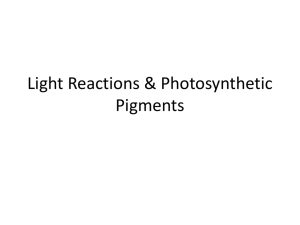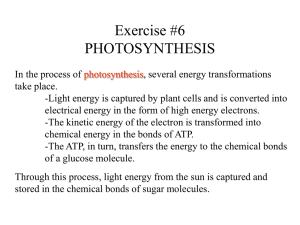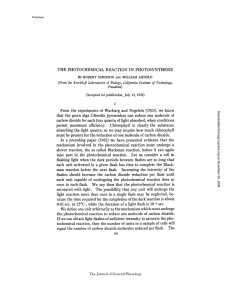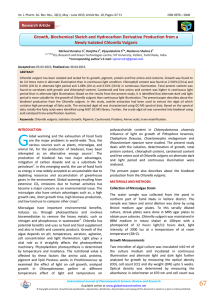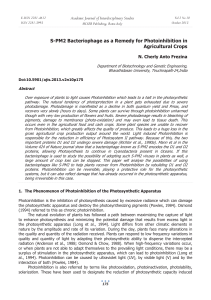SBI4U1_02_06_Light Energy_Pigments_Research
advertisement
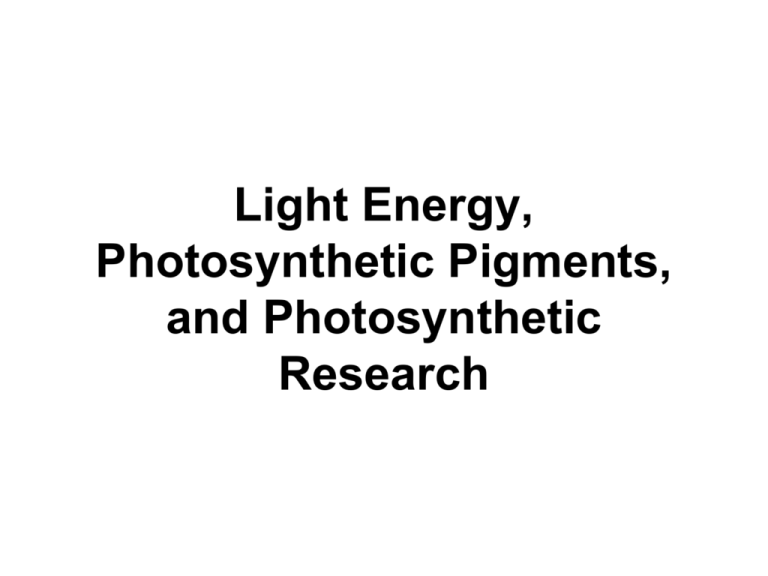
Light Energy, Photosynthetic Pigments, and Photosynthetic Research Electromagnetic Radiation • As photons pass through a prism they are separated according to their energies. – Forms Electromagnetic Spectrum. – Visible Spectrum: A narrow range that humans see (380 nm to 750 nm). Electromagnetic Radiation Why Are Plants Green? • Chlorophyll a & b: – Absorbs energy from blue-violet and red regions. – Reflects green light. • Chlorophyll a: – Transfers light energy to the carbon fixing reactions of photosynthesis. • Chlorophyll b: – An accessory pigment that absorbs photons that chlorophyll a absorbs poorly. Other Accessory Pigments • Carotenoids (e.g.,β-carotene): – Responsible for yellow-orange coloured leaves in fall. – Precursor of vitamin A helpful for low light vision. • Xanthophylls: – Responsible for yellow-coloured leaves in fall. • Anthocyanins: – Responsible for red-coloured leaves in fall. Photosynthetically Active Radiation (PAR) Light is absorbed from the entire visible spectrum when all pigments are combined. Photosynthetic Research J.B. Van Helmont (1600s) • Set out to study truth in common belief: – Plants obtained all food from soil. • Found that after 5 years the plant increased its mass more than the mass of soil lost. • Incorrect conclusion: – Increase in water due to absorption of water. Joseph Priestley (1771) • Conducted experiment with bell jar, candle and mint plant. • Discovered how gases play a role in photosynthesis. – Plants release a gas necessary for combustion. Jan Ingenhousz (1796) • Confirmed Priestley’s findings. • Discovered that plants release O2. • First to discover: – Sunlight essential for photosynthesis. – CO2 used by plants. • Incorrect conclusion: – Production of O2 from CO2. Light C.B. Van Niel (1930s) • Experimented with purple sulfur bacteria. – Bacteria absorb H2S and release sulfur gas. • Conclusion: – Plants absorb and split H2O to release O2. S.M. Ruben and M. Kamen (1938) • Confirmed Van Niel’s findings. • Placed Chlorella in “heavy” water. – Used mass spectrometer to detect heavy oxygen released by Chlorella. • Placed Chlorella in “normal” water containing “heavy” carbon dioxide. – Normal oxygen was released by Chlorella. F.F. Blackman (1905) • Determined the following: – At low light intensities, rate of photosynthesis increases as light intensity increases (not temperature). – At high light intensities, rate of photosynthesis increases by increasing the temperature (not light intensity). F.F. Blackman (1905) • Conclusion: – Occurs in 2 stages: 1. Light-dependant (photochemical). 2. Light-independent (biochemical) F.F. Blackman (1905) • Also determined the following: – Rate of photosynthesis decreases when the availability of CO2 is limited. Light Reactions • Photons excite electrons in the chlorophyll (in the thylakoid membrane). • Chemiosmotic ATP synthesis and formation of NADPH. The Calvin Cycle • Incorporation of CO2 into organic compounds such as glucose. • Endergonic: – Requires ATP and reducing power of NADPH. • Occurs in the stroma via Calvin Cycle.






